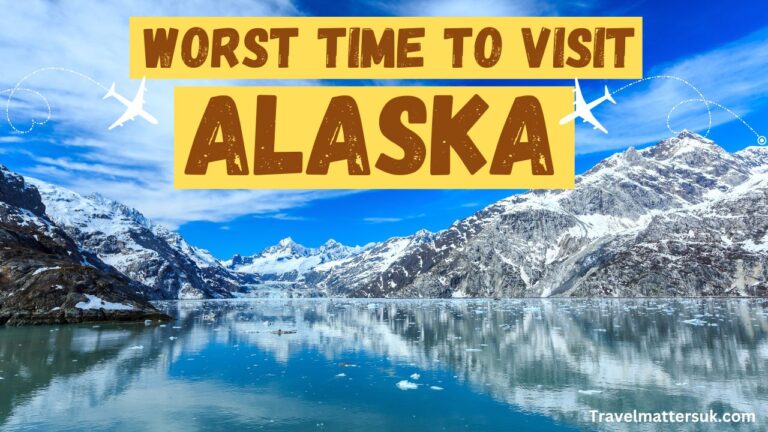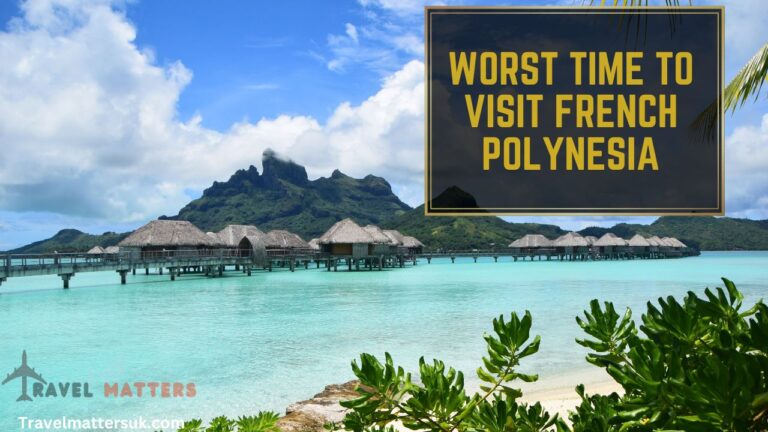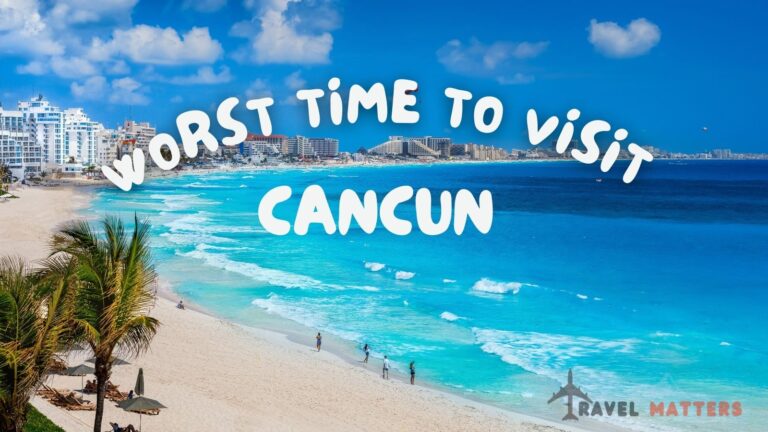When is the Worst Time to Visit Jamaica?
With its beautiful beaches, lush rainforests, and vibrant culture, Jamaica is a top Caribbean destination that attracts over 4 million visitors per year. But when is the best time to visit Jamaica and avoid the largest crowds and worst weather conditions?
This guide will overview the climate, events, and travel seasons in Jamaica to help determine the least ideal times to visit. By avoiding the worst months for weather and crowds, you can have a more enjoyable Jamaican vacation.

Overview of Jamaica’s Climate and Seasons
Jamaica has a tropical climate consisting of two main seasons – wet and dry.
The dry season runs from mid-December to mid-April. This peak tourist season brings drier weather and smaller chances of rain. It’s the most popular time to visit.
The wet season spans from May to November. During these months, Jamaica sees significantly more rainfall, especially from June through August. However, rain showers typically pass quickly.
Temperatures stay consistent year-round, averaging 30°C (86°F) along the coast. Heat and humidity peak from July to September.
Hurricane season officially runs from June to November, with the greatest risk from late August through October.
Avoid Peak Season Crowds
The busiest and most expensive travel times in Jamaica closely align with the dry season months of mid-December to mid-April.
December to mid-April brings excellent weather and smaller chances of rain. However, crowds are at their peak, hotel rates skyrocket, and availability becomes limited.
Trying to book Christmas, New Year’s or Spring Break requires planning many months in advance. Flights also jump in price during these peak holiday times.
January and February are ideal weather-wise with low rain chances, but hotels operate at 90% capacity. Major resort areas like Montego Bay and Ocho Rios teem with tourists. Attractions have long lines.
If crowds and high prices are unappealing, it’s best to avoid peak season. While the weather is fantastic, the crowds and congestion diminish the island’s laidback vibe.
Avoid the Wettest Weather
June through November brings Jamaica’s wet season with more heat, humidity and frequent downpours. The chances of rain are highest from May to early June and late August to November.
During these periods, expect short heavy showers most days that clear quickly. Rain typically falls in the afternoon and evenings. Mornings are often sunny.
September and October are the worst months in terms of weather, bringing the most rain, the highest humidity, potential storms, and prime hurricane season. Travel is not recommended.
Avoid late August through mid-November if you don’t want to risk wetter weather. While rain showers won’t ruin a trip, the muggy heat can be uncomfortable.
Steer Clear of Hurricane Season
The official Atlantic hurricane season lasts from June 1 to November 30, which overlaps with Jamaica’s wet season. However, the greatest threats exist from late August through October.
During this peak hurricane period, major storms have the chance to impact the island, bringing intense winds, rain, storm surges, and flooding.
It’s challenging to predict exact hurricane dates and paths months in advance. But visiting in late summer and early fall does present a greater risk of storms.
For the best chance of missing storms, avoid travel to Jamaica in September and October when powerful hurricanes are most likely to strike.
Avoid Jamaican Holidays and Events
Like other popular Caribbean destinations, Jamaica sees bigger crowds and hotel rates around certain holidays and annual events. It’s best to avoid travel during these peak times when demand skyrockets.
Some of Jamaica’s busiest festivals and events include:
- Reggae Sumfest (Montego Bay) – Late July
- Independence Day – Early August
- National Heroes Day – Third Monday in October
- Christmas and New Year’s – Late December
Other big Jamaican events like concerts or sporting events can also drive up hotel prices, especially in Kingston or Montego Bay.
Do research on your destination before booking flights and rooms around these dates. You’ll encounter larger crowds and less availability if vacation during major holidays or events.
The Worst Time to Visit Jamaica
Taking weather, crowds, prices, and events into consideration, September through early November is generally the worst time for most travelers to visit Jamaica:
- The rainy season is in full swing, with high humidity and chances of storms.
- September and October fall within the peak hurricane season.
- Rainy weather keeps crowds moderate, along with lower hotel occupancy.
- Some resorts and restaurants may close for maintenance and renovations.
- Attractions and tours operate on reduced schedules.
- Peak season rates don’t apply, but costs are higher than the rest of the low season.
You can still find good flight and hotel deals during these wetter months. But weather conditions are least ideal for a beach getaway.
For the best odds of great weather, smaller crowds, lower prices, and full operation of resorts and attractions, it’s better to avoid Jamaica in early fall.
The Best Times to Visit Jamaica
If you’re looking for the ideal climate, smaller crowds, and costs, the best times are:
- Mid-April to May – Just before the wet season, with lovely weather and wildflower blooms.
- Mid-June to early July – Summer temperatures without excessive rain.
- Mid-November to mid-December – Drier weather before the Christmas rush.
During these shoulder season months, you’ll enjoy:
- Warm temperatures with low rain chances
- Smaller crowds and ample hotel availability
- Lower rates and airfares
- Full amenities and service at hotels
- No risk of hurricanes or storms
- Key attractions open with fewer tourists
Aim for a spring or late fall trip to experience Jamaica’s beauty minus the big crowds and peak pricing.
Tips for Visiting in the Wet Season
If wet season travel can’t be avoided, here are some tips to make the most of your Jamaica vacation:
- Book earlier – Take advantage of lower room rates and better availability.
- Pack for humidity – Bring lightweight, breathable fabrics that dry quickly. Have closed-toe shoes, rain jackets, and umbrellas handy.
- Check forecasts – Monitor forecasts so you can plan indoor or covered activities if heavy rain is expected. Downpours often pass quickly.
- Have wet weather options – Indoor attractions, spa days, and culinary tours.
- Get trip insurance – In case a hurricane disrupts plans.
- Avoid September/October – Steer clear of the peak hurricane threat period.
- Stay at larger resorts – They’re less likely to close and have more amenities.
- Enjoy lower costs – Take advantage of reduced hotel rates and airfares.
- Choose a resort with extensive amenities – Pick a larger resort that has a variety of on-site facilities like spas, fitness centers, restaurants, and lounges to keep you occupied if the weather is bad.
- Opt for covered tours – Take excursions like plantation or culinary tours that are more protected from the elements versus beach activities.
- Visit attractions early – Get to popular sights first thing in the morning when rainfall is less likely.
- Have a backup plan – Research nearby attractions or alternate activities in case rain disrupts your original plans.
- Take advantage of lower rates – Book tours, excursions and nice dinners at resorts at lower wet season prices.
- Head to drier parts of the island – The south coast and Portland Parish see less rain compared to other areas.
- Enjoy smaller crowds – With fewer tourists, popular attractions will be less crowded and busy.
- Relax at the resort – Sleep in, get a massage, read by the pool. Rainy periods allow time to slow down and indulge.
- Wait out showers – Brief downpours often pass quickly, so take temporary cover then resume your plans.
Planning ahead and staying flexible will allow you to make the most of a Jamaica trip any time of year, even in the wet season. You can still have an amazing experience by working around the rain.
With the right mindset and preparations, you can still have an amazing trip during Jamaica’s wet season. The key is managing expectations and staying flexible.
Frequently Asked Questions
What months have the worst weather in Jamaica?
September and October generally have the worst weather, with hot temperatures, high humidity, frequent rain showers and storms, and peak hurricane season.
When is hurricane season in Jamaica?
Jamaica’s official hurricane season lasts from June 1 to November 30, but the greatest risk period is late August through October when powerful storms are most likely.
When are crowds the biggest in Jamaica?
Peak tourist season is mid-December through mid-April, especially around the winter holidays and spring break. This dry season sees the most visitors, highest hotel rates and biggest crowds.
Should I avoid visiting Jamaica in September?
Yes, September is likely the worst month for travel to Jamaica. The rainy season is going strong, hurricane threats peak, some resorts close, and the weather is hot, muggy and wet. It’s better to plan trips for drier months.
What is the cheapest time to visit Jamaica?
The cheapest time is during the wet season in late spring (May) and late fall (mid-November to mid-December). Lower demand brings better deals on airfare and hotels before peak season rates take effect.
By dodging Jamaica’s worst weather and crowds, you can have an idyllic Caribbean getaway. Aim for shoulder seasons in the spring or fall for ideal conditions at lower costs.






